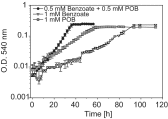Simultaneous catabolism of plant-derived aromatic compounds results in enhanced growth for members of the Roseobacter lineage
- PMID: 23563956
- PMCID: PMC3675927
- DOI: 10.1128/AEM.00405-13
Simultaneous catabolism of plant-derived aromatic compounds results in enhanced growth for members of the Roseobacter lineage
Abstract
Plant-derived aromatic compounds are important components of the dissolved organic carbon pool in coastal salt marshes, and their mineralization by resident bacteria contributes to carbon cycling in these systems. Members of the roseobacter lineage of marine bacteria are abundant in coastal salt marshes, and several characterized strains, including Sagittula stellata E-37, utilize aromatic compounds as primary growth substrates. The genome sequence of S. stellata contains multiple, potentially competing, aerobic ring-cleaving pathways. Preferential hierarchies in substrate utilization and complex transcriptional regulation have been demonstrated to be the norm in many soil bacteria that also contain multiple ring-cleaving pathways. The purpose of this study was to ascertain whether substrate preference exists in S. stellata when the organism is provided a mixture of aromatic compounds that proceed through different ring-cleaving pathways. We focused on the protocatechuate (pca) and the aerobic benzoyl coenzyme A (box) pathways and the substrates known to proceed through them, p-hydroxybenzoate (POB) and benzoate, respectively. When these two substrates were provided at nonlimiting carbon concentrations, temporal patterns of cell density, gene transcript abundance, enzyme activity, and substrate concentrations indicated that S. stellata simultaneously catabolized both substrates. Furthermore, enhanced growth rates were observed when S. stellata was provided both compounds simultaneously compared to the rates of cells grown singly with an equimolar concentration of either substrate alone. This simultaneous-catabolism phenotype was also demonstrated in another lineage member, Ruegeria pomeroyi DSS-3. These findings challenge the paradigm of sequential aromatic catabolism reported for soil bacteria and contribute to the growing body of physiological evidence demonstrating the metabolic versatility of roseobacters.
Figures




References
-
- Boerjan W, Ralph J, Baucher M. 2003. Lignin biosynthesis. Annu. Rev. Plant Biol. 54:519–546 - PubMed
-
- Higuchi T. 1990. Lignin biochemistry: biosynthesis and biodegradation. Wood Sci. Technol. 24:23–63
-
- Wakeham SG, Schaffner C, Giger W. 1980. Polycyclic aromatic hydrocarbons in Recent lake sediments—I. Compounds having anthropogenic origins. Geochim. Cosmochim. Acta 44:403–413
-
- Christian JR, Anderson TR. 2002. Modeling DOM biogeochemistry, p 717–755 In Hansell DA, Carlson CA. (ed), Biogeochemistry of marine dissolved organic matter. Academic Press, San Diego, CA
Publication types
MeSH terms
Substances
LinkOut - more resources
Full Text Sources
Other Literature Sources
Molecular Biology Databases

